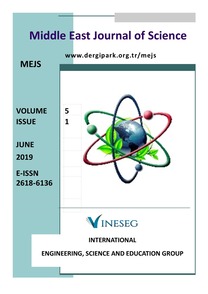FATTY ACID CONTENTS OF TWO EDIBLE MUSHROOM SPECIES (CYCLOCYBEAEGERITA AND HYGROPHORUS EBURNEUS) COLLECTED FROM TOKATREGION
FATTY ACID CONTENTS OF TWO EDIBLE MUSHROOM SPECIES (CYCLOCYBEAEGERITA AND HYGROPHORUS EBURNEUS) COLLECTED FROM TOKATREGION
___
- [1] Anderson, S.C., Cockayne, S., “Clinical Chemistry Concepts and Application”, McGraw-Hill, Medical Publishing Division, 2003.
- [2] Ayaz, F.A., Torun, H., Özel, A., Çöl, M., Duran, C., Sesli, E., Çolak, A., “Nutritional value of some wild edible mushrooms from Black Sea Region (Turkey)”, Turkish Journal of Biochemistry, 36(3), 213-221, 2011.
- [3] Pekşen, A., Kibar, B., Yakupoğlu, G., “Yenilebilir bazı Lactarius türlerinin morfolojik özelliklerinin, protein ve mineral içeriklerinin belirlenmesi”, OMÜ Zir. Fak. Dergisi, 22(3), 301-305, 2007.
- [4] Pekşen, A., Yakupoğlu, G., Kibar, B., "Some chemical components of Lactarius pyrogalus from diverse locations”, Asian Journal of Chemistry, 20(4), 3109-3114, 2008.
- [5] Demirbaş, A., “Concentrations of 21 Metals in 18 Species of Mushrooms Growing in the East Black Sea Region”, Food Chemistry, 75, 453-457, 2001.
- [6] Manzi, P., Aguzzi, A., and Pizzoferrato, L., “Nutritional value of mushroom widely consumed in Italy”, Food Chemistry, 73, 321-325, 2001.
- [7] Barros, L., Baptista, P., Correia, D.M., Casal, S., Oliveira, B., Ferreira, I.C.F.R., “Fatty acid and sugar compositions, and nutritional value of five wild edible mushrooms from Northeast Portugal”, Food Chemistry, 105, 140-145, 2007.
- [8] Bon, M., The Mushrooms and Toad stools of Britain and North-Western Europe, Hodder-Stoughton, London, 1987.
- [9] Breitenbach J., Kränzlin F., Fungi of Switzerland. Vol: 3, Boletes and Agarics 1. Part, VerlagMykologia CH-6000 Luzern 9, Switzerland, 1991.
- [10] Breitenbach, J., Kränzlin, F., Fungi of Switzerland. Vol: 4, Agarics 2. Part, Verlag Mykologia CH-6000 Luzern 9, Switzerland, 1995.
- [11] Jordan, M., The Encyclopedia of Fungi of Britain and Europe, Frances Lincoln, London, 1995.
- [12] Moser, M., Keys to Agarics and Boleti, Gustav Fischer Verlag, Stuttgart, 1983.
- [13] Phillips, R., Mushrooms and Other Fungi of Great Britain & Europe, Pan Books Ltd., London, 1981.
- [14] Kirk, P., Index Fungorum, URL:http://www.indexfungorum.org (accessed 25 March 2020), 2011.
- [15] Christie, W.W., Gas Chromatography and Lipids: A Practical Guide,The Oily Press Ltd. Scotland, 1990.
- [16] Hara, A., Radin, N.S., “Lipid extraction of tissues with a low-toxicity solvent”, Analytical Biochemistry, 90, 420-426, 1978.
- [17] Petrović, J., Glamočlija, J., Stojković, D., Ćirić, A., Barros, L., Ferreira, I.C.F.R., Soković, M., “Nutritional value, chemical composition, antioxidant activity and enrichment of cream cheese with chestnut mushroom Agrocybe aegerita (Brig.) Sing”, The Journal of Food Science and Technology, 52(10), 6711–6718, 2015.
- [18] Ergönül, P.G., Ergönül, B., Kalyoncu, F., Akata, I., “Fatty acid compositions of five wild edible mushroom species collected from Turkey”, International Journal of Pharmacology, 8(5), 463- 466, 2012.
- [19] Durmaz, F., Aktaş, S., Şimşek Sezer, E.N., “Bovista plumbea Pers.'nın yağ asiti içeriklerinin incelenmesi”, Mantar Dergisi ,8(2), 104-108, 2017.
- [20] Işık, H., Türkekul, İ., Çınar Yılmaz, H., Bengü, A.Ş., “Determination of fatty acid profile and mineral contents of Tricholomopsis rutilans collected from Yozgat” Anatolian Journal of Botany, 3(2), 64-68, 2019.
- [21] Bengü, A.Ş., “Some elements and fatty acid profiles of three different edible mushrooms from Tokat province in Turkey”, Progress in Nutrition, 21-1, 189-213, 2019.
- ISSN: 2618-6136
- Yayın Aralığı: 2
- Başlangıç: 2015
- Yayıncı: -
Aydın Şükrü BENGÜ, İbrahim TÜRKEKUL, Hakan IŞIK, Handan ÇINAR YILMAZ
X-RAY PROPERTIES OF THE NON-COOL-CORE CLUSTER OF GALAXIES ABELL 2147
A REVERSE HÖLDER INEQUALITY IN L^p(x)(Ω)
THE EFFECTS OF THE MN2+ IONS ON THE MORPHOLOGICAL PROPERTIES OF ZINCOXIDE THIN FILMS
Handan ÇINAR YILMAZ, Hakan IŞIK, Aydın Şükrü BENGÜ, İbrahim TÜRKEKUL
ON SOME RESULTS OF WEIGHTED HÖLDER TYPE INEQUALITY ON TIME SCALES
